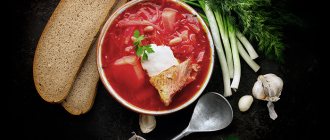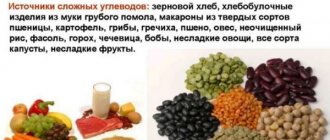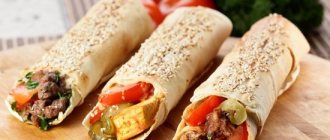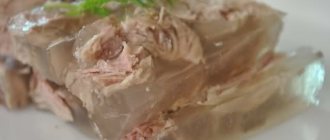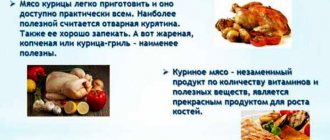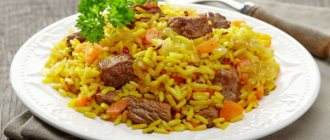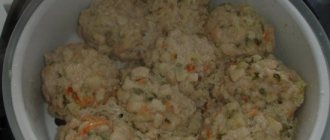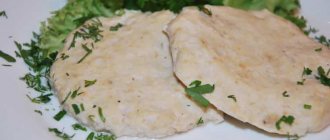Calorie content of pilaf and BJU
There are many recipes for pilaf, which differ in the meat and herbs used in preparation.
Pilaf - the oldest dish on the planet
Main ingredients:
- Rice. On average, its calorie content is 340 kcal per 100 grams. High numbers are due to starch, which is easily converted by the body into sugar.
- Meat is perceived as the most nutritious. In fact, even with a fat layer, the ingredient is inferior to rice in this parameter. On average, there are 200-230 kcal per 100 grams. Yes, meat can add extra calories, but you can reduce the richness of the dish by selecting lean cuts.
- Oil, fat. These components add energy value. But the weight in the total mass is small if they are used without fanaticism.
- Spices. The share in calorie content is negligibly small.
The energy value of an average serving of pilaf is 150 kcal.
The table shows specific BZHU figures:
| Recipe | Kilocalories/100 grams | Kcal per serving | Squirrels | Fats | Carbohydrates |
| Lenten (no meat) | 60 | 160 | 1 | 1 | 12 |
| With Chiken | 160 | 360 | 8 | 20 | 30 |
| With pork | 200 | 430 | 7 | 10 | 23 |
| With beef | 220 | 415 | 8 | 4 | 73 |
| With lamb | 150 | 432 | 6 | 10 | 9 |
| With turkey | 165 | 400 | 10 | 4 | 23 |
| With a rabbit | 185 | 455 | 16 | 7 | 16 |
Which has fewer calories: beef, pork or lamb?
Pork is one of the fattest types of meat, so the calorie content of pilaf with it is the highest. But it can be reduced if you choose the leanest pieces of meat for cooking and cut off all the pieces of lard and fat.
Calculating the calorie content of pilaf with pork is not particularly difficult, if you take into account the combination of meat, rice and vegetables, you get from 290 to 320 kcal per 100 grams. The fairly large number of calories that pork pilaf contains is quite understandable - this meat is quite fatty and heavy.
Of all the possible variations and recipes considered, this one has the highest score. The calorie content of pilaf with pork is very high, so it is better for overweight people to refuse or limit the consumption of this type of meat, replacing it with lighter and less calorie meat.
For those who like to eat well, without denying themselves anything, and who are accustomed to watching their figure, it is better to give preference to beef, its energy value is much lower and is more acceptable for dietary nutrition. The calorie content of pilaf with beef is about 220-240 kcal per 100 g.
Recipes for dietary and low-calorie dishes
If you cook pilaf from lean meat with a lot of vegetables, choose a type of rice with a low starch content, you will get the least high-calorie food.
It is better to use refined, purified oil for cooking or use methods for cooking that exclude its use.
Chicken pilaf in a slow cooker
A low calorie dish: 100 kcal per 100 grams.
Ingredients:
- Chicken breast – 500 g.
- Rice - 2 cups multicooker. Long grain contains less starch.
- Onions – 200 g.
- Carrots – 200 g.
- Garlic – 3 cloves.
- Seasonings to taste: turmeric, pepper, salt.
Preparation:
- The meat is cut into pieces.
- Onions and carrots are chopped.
- The products are placed in the multicooker bowl and cooked for 5 minutes.
- Spices are added and everything is thoroughly mixed.
- Rice is added.
- Water is poured in proportion to the total volume of the remaining ingredients 1:1.
- Everything is stewed in the “Pilaf” mode for about 40 minutes.
Low calorie meal without meat
An even lower calorie dish: 70 kcal per 100 grams.
Low-calorie pilaf without meat
Ingredients:
- Rice – 200 g (preferably oblong).
- Carrots – 2 pcs.
- Onion – 3 pcs.
- Garlic – 1 head.
- Vegetable oil is the standard amount for frying.
- Seasonings to taste.
Preparation:
- Vegetables are chopped (onions finely, carrots using a grater) and fried in vegetable oil.
- Rice is added and lightly fried.
- The mixture is placed in a deep metal thick-walled container, preferably a cauldron, and filled with water.
- Garlic is added with cloves, seasonings and salt are added.
- The dish is simmered covered over low heat until cooked.
Contents of the BZHU
The content of proteins, carbohydrates and fats in pilaf will vary depending on the ingredients used and their quantity. Therefore, the definition of BJU in pilaf is very conditional. Also, the difficulty of the definition lies in the fact that the dish is multi-component, so the BJU indicators are calculated on average for certain proportions of all components.
| vegetable oil | 120 ml |
| beef | 350 g |
| carrot | 400 g |
| onion | 250 g |
| fluffy rice | 400 g |
| water | 1 l |
For pilaf prepared from the above quantities of components, the content of BZHU and other components per 100 g will be as follows:
- fat content – 9 g;
- carbohydrate content – 17 g;
- protein content – 4.9 g;
- water content – 69 g;
- dietary fiber content – 1.1 g.
How else can you reduce the calorie content of a product?
A few tips to help further reduce the energy value of pilaf:
- To prepare dietary pilaf, it is not necessary to choose lean meat. You can prepare it yourself by carefully removing the fat. This method will remove up to half the calories.
- Instead of vegetable oil, it is better to use olive oil and under no circumstances use lard.
- When cooking, use a minimum of spices. Instead of the usual salt, use soy sauce.
- Use long grain oblong or brown rice. You can even try making pilaf from black “wild” rice. All these varieties have lower starch content.
- Prepare the dish without oil or fat , steamed or in a slow cooker.
- Add more vegetables to the pilaf. This will not spoil the taste, but will seriously reduce the fat content and make the dish more juicy. Adding mushrooms will reduce the mass fraction of meat and will not affect the taste. Garlic, tomatoes, potatoes - Indian version.
- You can use chickpeas instead of rice. Cereals contain a lot of potassium and calcium. In terms of the amount of protein per 100 grams, it surpasses buckwheat - 14 versus 19. Using this legume, it is recommended to make pilaf without meat or reduce its amount.
- Replace meat with dried fruits.
Be sure to read: How many calories are in oatmeal porridge with water and milk, calorie content of oatmeal with honey per 100 grams
The product prepared using the listed life hacks has all the beneficial properties of the traditional one.
Pilaf is also rich in potassium, vitamins A, B and C, fiber, it contains iodine and other useful substances. Even one of the fattiest varieties of the dish, pork pilaf, can be made leaner by following these instructions.
How many calories are in pilaf 100 grams
It should be noted that pilaf is absorbed by the human body by 99 percent, according to nutritionists. Although it has a fairly high calorie content, it is completely processed, which means that in any case it will not affect the figure with moderate consumption. In addition, the main components contain a lot of various useful substances and vitamins. The indicator, how many calories are in one hundred grams of pilaf , depends on what ingredients you use. In the classic recipe, in particular, there are:
- rice;
- carrot;
- onion;
- spices (barberry, cumin, turmeric, etc.);
- salt;
- meat;
- garlic;
- water.
The main component that affects the calorie content of pilaf is meat. The original recipe, which has been passed down from generation to generation, contains lamb. About 236 kcal - that’s how many calories are in lamb pilaf . It's not that much. Please also note that pilaf is a nutritious dish; after eating a 300-gram portion, you will not feel hungry for a long time.
Delicious recipes for pilaf with beef
Beef pilaf, the calorie content of which is approximate in the recipes, has many cooking options. It can be cooked in a cauldron, in a frying pan, in a saucepan, in pots or using a slow cooker. Also, when preparing pilaf with beef, you can experiment with different types of rice and ingredients - mushrooms, raisins, chickpeas.
In an Uzbek cauldron with mushrooms
In traditional recipes, lamb is used when preparing this dish, but even with beef, this dish turns out to be very aromatic and satisfying.
To prepare pilaf in a cauldron with mushrooms and beef, take:
- rice (basmati or devzir) – 1 kg;
- onion – 3-4 heads;
- carrots (preferably yellow) – 1 kg;
- garlic – 2 heads;
- beef – 1 kg;
- vegetable oil – 150 g;
- hot pepper – 1-2 pods;
- turmeric;
- cumin;
- salt.
First you need to prepare the products:
- Rinse all the rice thoroughly (the water should be clear).
- Cut the meat into medium-sized pieces.
- Peel the carrots and cut them into thin strips.
- Peel garlic and onions. Cut the onion into rings and leave the garlic whole.
Prepare the dish like this:
- Heat vegetable oil in a cauldron.
- After 5-7 minutes. Add a pinch of salt, cumin, turmeric and onion cut into rings to the oil and wait until it turns golden brown.
- Next, add the meat and fry for 10-12 minutes.
- After this, carrots are sent to the cauldron.
- After 10-15 minutes, add water, about 1 liter, to the cauldron and let it boil, after which hot pepper and garlic are added. Then turn down the heat and leave everything to simmer for 30 minutes.
- After 30 minutes, remove the pepper and garlic onto a separate plate, and add the washed rice to the water, increasing the heat before doing so.
- Using a slotted spoon, level the rice over the entire surface and reduce the heat again. You cannot mix it with meat and vegetables; it must be gradually soaked in the resulting sauce. The finished rice should be firm and crumbly, but not hard in taste.
- Before turning off, make a depression in the center of the dish in the cauldron using a spoon and place the previously laid out garlic and pepper into it.
- After turning off the pilaf, cover it with a lid and a towel and let it stand for 15-20 minutes.
The calorie content of finished pilaf with beef is about 250 kcal, while the calorie content of pilaf with lamb will be slightly higher - 297 kcal per 100 g.
In a saucepan on the stove with steamed rice and barberries
You can prepare delicious pilaf not only in a cauldron, but also in an ordinary pan.
To do this take:
- 400 g rice (parboiled);
- 500 g meat;
- 300 g carrots;
- 250 g onions;
- 2 heads of garlic;
- 0.95 l of water;
- 100-150 ml vegetable oil;
- spices to taste:
- salt;
- barberry;
- turmeric;
- khmeli-suneli;
- pepper.
Prepare the dish like this:
- The meat is washed, cut into not too large pieces and sprinkled with spices.
- Pour oil into a thick-bottomed pan and let it heat over medium heat.
- Peeled onions are cut into half rings and sent into heated oil along with the prepared meat.
- While the onions and meat are stewing, the peeled carrots should be cut into thin strips. After 15-20 minutes. the meat and onions are covered with prepared carrots and spices are added (barberry, suneli hops, pepper, salt, turmeric). Simmer everything together over low heat for about 20 minutes.
- After 20 min. Add washed rice to vegetables and meat, pour 3.5 cups of boiled water over it and level it.
- Cover the pan with a lid, turn up the heat and simmer until all the liquid has evaporated, about 10 minutes.
- After this, the fire is reduced, and the rice is pierced in several places with a wooden stick and simmered for about another 5-7 minutes.
The calorie content of pilaf with barberry cooked in a pan is 265 kcal.
With brown rice in a frying pan
In addition to cauldrons and saucepans, thick frying pans with high sides are also suitable for preparing pilaf.
To prepare pilaf with beef and brown rice, which is not only very healthy, but also lower in calories compared to other types, you will need:
- beef meat (fillet) – 0.5 kg;
- onions – 2-3 pcs.;
- carrots – 2-3 pcs.;
- sunflower oil – 150-200 ml;
- turmeric;
- cumin;
- peppercorns;
- head of garlic;
- salt;
- ground black and red pepper.
- brown rice – 300 g.
The brown type of rice is very healthy, but it does not boil well and therefore the pilaf from it always turns out crumbly.
Pilaf is prepared from this rice as follows:
- The rice is pre-washed several times.
- The meat is also washed and cut into small pieces.
- Then peel and cut the onion (you can use half rings, rings or just cubes).
- Peeled carrots are chopped into strips.
- The husk is removed from the head of garlic, but not completely removed.
- Then pour oil into a frying pan with a thick bottom and heat it thoroughly.
- Place the meat in the heated oil and fry, stirring until all the liquid has evaporated.
- After this, add the onion to the meat and lightly fry it for 5-7 minutes.
- After 5-7 minutes. carrots are added to the frying pan.
- After the carrots are fried, pour water into the frying pan so that it is 2-3 cm higher than all the products and cook everything for about 30 minutes, covering with a lid. During this time, zirvak is formed - it is this that will give the coarse brown rice its main taste. At the end of cooking, add turmeric, salt and pepper to the zirvak.
- Next, add the rice in an even layer, without mixing it with the meat and vegetables, add water and simmer the pilaf for another 1 hour over low heat.
- 10-15 minutes before readiness, add a head of garlic to the pilaf.
- After turning off the pilaf, cover it with a plate and a lid on top so that the brown rice is completely saturated with zirvak.
The calorie content of pilaf with beef made from brown rice is significantly lower.
The calorie content of finished pilaf with brown rice is approximately 135 kcal per 100 g.
With chickpeas and raisins in layers in a slow cooker
You can prepare crumbly and tasty pilaf in a slow cooker.
To prepare an unusual pilaf with raisins and chickpeas you will need:
- vegetable oil – 150 ml;
- water – 360 ml;
- raisins – 30 g;
- onions – 2-3 pcs.;
- meat (beef fillet) – 500-600 g;
- carrots – 600-700 g;
- garlic – 2 heads;
- rice – 400-500 g;
- chickpeas (round peas) – 200 g;
- raisins (yellow) – 100 g;
- spices:
- cumin;
- curry;
- turmeric;
- salt.
Prepare this dish in a slow cooker as follows:
- The chickpeas are pre-soaked for at least 5-6 hours or overnight and then boiled for about 40 minutes.
- For zirvak, vegetables are prepared - they are peeled and the carrots are cut into thin strips and the onion into half rings.
- Rice and raisins are thoroughly washed and filled with boiled hot water in different containers.
- Pour oil into the multicooker bowl, add onion and chopped meat. In the multicooker menu, select the “Baking” mode and set the time for 20 minutes.
- After 20 min. cumin, curry and turmeric are added to the vegetables and onions, carrots are poured on top and the vegetables are included again and the meat is cooked for another 20 minutes. Do not mix the ingredients in the slow cooker after adding carrots.
- In 20 minutes. Place boiled chickpeas and raisins on top of the carrots and insert a whole head of garlic into the carrots (the husks should not be completely peeled), and pour washed rice on top and pour boiled water over the entire dish. In this form, the dish is cooked on the “Pilaf” mode for 50-60 minutes.
The calorie content in such pilaf will be quite high due to the abundance of protein, which chickpeas and meat are rich in, and will be about 330 kcal per 100 g.
In the oven in pots with bulgur
Bulgur is steamed, crushed and dried cereal grains made from shelled wheat. It goes well with various types of meat, including beef.
To prepare bulgur pilaf with beef in pots, you need the following ingredients (for 3-4 pots):
- lean beef – 400 g;
- bulgur – 150 g;
- onion – 100 g;
- carrots – 350 g;
- olive oil – 15 g;
- salt;
- pepper
- water – 250 ml.
Cooking such pilaf in pots is not at all difficult:
- Vegetable (olive) oil is poured into each pot.
- Cut onions and carrots into medium-sized cubes (carrots can also be cut into short strips), add pepper and salt, and place them on the bottom of the pots;
- The meat is washed, cut into pieces and placed on top of the vegetables, distributing approximately equally in each pot.
- The cereal is washed and placed on top of the meat, leveling it on top, and seasoned with salt.
- Boiled water is poured into each pot so that it is 1-1.5 cm above the cereal layer and placed in the oven for 45-50 minutes at 180C.
The calorie content of the finished dish is low - 120 kcal per 100 g.
With boiled meat for a diet menu
Another option for preparing dietary pilaf is a method in which the meat is pre-boiled.
For preparation take:
- beef – 500-600 g;
- onions – 1-2 pcs.;
- carrots – 2 pcs.;
- rice (long grain) – 250 g;
- olive oil – 2-3 tbsp;
- salt.
In fact, all the components of dietary pilaf are identical to the usual version, the difference lies in the method of preparing the meat, the exclusion of spices and the replacement of fatty sunflower oil with olive oil.
Pilaf is prepared like this:
- The beef is boiled and cut into pieces.
- In a frying pan, fry chopped onions and grated carrots in olive oil.
- The rice is washed and placed in a frying pan, spreading it evenly on top of the vegetables. Fill everything with water so that it is 1.5-2 cm higher than the rice.
- Rice and vegetables are stewed for 40-45 minutes. Before serving, add meat to the rice.
The calorie content of such pilaf will be approximately 180 kcal per 100 g.
With Shirataki rice according to Dukan's recipe
Shirataki rice is a natural plant product that contains a large amount of dietary fiber and is characterized by an almost complete absence of calories. Pilaf with beef and rice of this variety turns out to be very light, but at the same time appetizing.
For preparation take:
- shirataki rice – 200 g;
- lean beef – 350-400 g;
- onion – 1 pc.;
- carrots – 1 pc.;
- tomato paste – 1 tsp.
Pilaf is prepared like this:
- The meat is cut into pieces and stewed in tomato paste for about 10 minutes.
- Then carrots and onions cut into thin strips are added to the meat, and rice is added. Simmer everything for 25-30 minutes.
Stewing makes the rice tasty and soft. The calorie content of the finished dish is approximately 86 kcal per 100 g.
There are many options for preparing pilaf. Among the variety of recipes, people who want to lose weight can easily choose the appropriate way to prepare this delicious dish. One such way is to prepare this dish with beef.
Its calorie content will be lower than that of traditional pilaf with lamb or pork, which will help maintain normal weight and provide a satisfying and varied diet.
Beef pilaf and diet
Beef pilaf, whose calorie content is lower than a similar dish with pork or lamb, can be consumed by people who want to lose weight. There are many diets that include rice, as well as a separate mono-diet based on this product.
Beef meat, in turn, does not contain much fat, unlike pork and lamb. However, this does not mean that pilaf can be consumed in any quantity.
If you are on a diet or following proper nutrition, you should not include this dish in your diet more than 1-2 times a week.
Also, if you want to lose weight, you should remember the features of preparing this dish:
- Do not add fatty bacon and a lot of spices;
- It is better to steam all the ingredients separately and combine them immediately before serving, this will help to significantly reduce calorie content;
- You can add a little more vegetables, and reduce the amount of rice and meat;
- It is preferable to cook pilaf not with full-fat sunflower oil, but with olive or coconut oil;
- It is advisable to monitor the amount of food eaten and reduce the usual portion by half.

